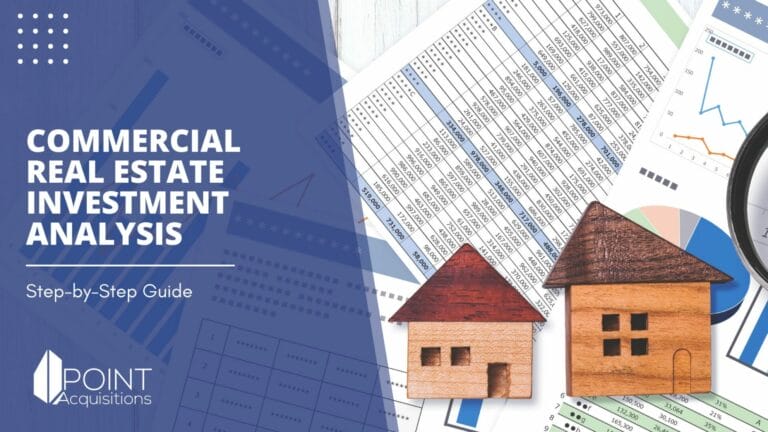
Mastering Commercial Real Estate Investment Analysis: Your Step-by-Step Guide
Understanding commercial real estate investment analysis is crucial for converting data and insights into tangible returns. With over $1 trillion in commercial real estate transactions annually in the United States alone, mastering these skills is key for capitalizing on this lucrative market.
This guide cuts to the core of commercial real estate investment analysis, offering a clear, concise outline of the critical frameworks and tools that inform savvy investment decisions. Expect to walk away with a firm grasp on the metrics and evaluations that define successful commercial property investments.
Table of Contents
Key Takeaways
- Commercial real estate investment analysis is vital for risk management, providing market insights, and enhancing investment success, requiring a deep evaluation of qualitative and quantitative factors, such as market cycles, property history, vacancy rates, rental rate growth, and financial metrics.
- The financial metrics crucial to commercial real estate analysis include Net Operating Income (NOI), capitalization rates, and cash-on-cash returns, which help assess property performance, valuations, and investment returns while considering the influence of lease terms and conditions.
- Risk assessment and mitigation are vital for protecting investments in commercial real estate, involving the identification of asset, tenant, and management risks, and implementing strategies such as diversification, prioritizing quality assets, maintaining optimal debt levels, securing insurance, and adopting emergency plans.
Understanding Commercial Real Estate Investment Analysis
Commercial real estate investment analysis, or commercial property analysis, acts as a beacon for investors. Key to identifying the right types of properties and classes to invest in, analyzing commercial real estate is a risk management tool. It provides valuable market insights and increases the chances of investment success.
A thorough analysis of commercial real estate investments is instrumental in meeting investors’ financial objectives and pinpointing lucrative opportunities.
The process involves a comprehensive evaluation of quantitative (hard numbers) and qualitative (subjective) factors influencing the viability of transaction prospects. It requires an in-depth understanding of industry fundamentals.
Becoming proficient in commercial real estate investment analysis is essential for uncovering the hidden profit potential within commercial properties. As each aspect of the property is scrutinized, investors gain a clearer picture of the financial rewards that may be reaped.
The Role of Investment Analysis
Investment analysis is the game plan that helps you navigate the field. It involves evaluating detailed income and operating expenses to determine the potential return on investment. Precise evaluation of financial details and risk assessment is key to maximizing returns on commercial real estate investments.
Risk assessment is another important role of investment analysis. It helps identify the risks present, from market fluctuations to tenant defaults and assesses the potential returns against these identified risks. A savvy investor identifies potential risks before investing.
Key Components of Investment Analysis
The solid base of effective investment analysis is built on a profound understanding of market fundamentals, including:
- vacancy rate
- rental rate growth
- amount of construction
- prices of comparable properties
Investment analysis also includes scrutinizing qualitative elements, such as the owner’s selling motivations, and quantitative aspects, like financial metrics that underscore property performance. Key quantitative metrics include:
- The loan-to-value ratio (LTV) for assessing leverage
- The debt service coverage ratio (DSCR) for evaluating repayment ability
- The operating expense ratio (OER) for profitability analysis
These metrics are necessary for achieving a profitable commercial real estate deal and ensuring the success of your investment.
Market Research for Commercial Real Estate Investments
Investors need to consider both macro-level market trends and specific micro-level details related to the property in question. It’s a dual-lens approach that provides a true view of the investment landscape. An investor shouldn’t dive into a deal without comprehensive market research.
Use online platforms such as LoopNet, CoStar, and CREXi to search for commercial properties and gather essential market data and analytics. Commercial real estate agents can also provide valuable market analysis, offering:
- demographic studies
- environmental research
- in-depth financial analyses
Public property records are another useful resource for researching sale price data and benchmarking against similar properties, invaluable in assessing a property’s market value.
Demographic and Economic Factors
Demographic and economic factors act as the driving force in commercial real estate. Changes in the local economy, like the emergence of new industries or the decline of existing ones, impact commercial real estate markets.
Demographic variables directly affect commercial real estate demand. These include:
- population growth – influences the demand for real estate as more people can mean a need for more buildings and services.
- employment trends – affect the types of commercial properties in demand, with job growth potentially increasing the need for office and industrial spaces.
- income levels – higher incomes can lead to increased spending and the need for more retail and luxury commercial spaces.
Macro-economic factors are also influential, affecting various markets differently. These include:
- Inflation – can erode purchasing power and lead to higher operating costs for property owners.
- Interest rates – influence borrowing costs, potentially affecting investors’ leverage and the overall demand for real estate.
- Unemployment – high levels can impact the demand for commercial spaces, as higher unemployment may reduce the need for office and retail spaces.
National economic indicators like GDP growth or fluctuating inflation levels can lead to challenges in commercial real estate, including delayed rent collections and increased vacancies.
Hyper-local market trends like population growth, economic drivers, and vacancy rates are crucial elements in the analysis of commercial real estate properties.
Supply and Demand Dynamics
An imbalance in the supply and demand for commercial real estate can influence property values and rental rates. Understanding where we are in the market cycle is crucial as it influences all aspects of commercial real estate regardless of the specific location.
The market cycle affects property values, rental rates, demand for space, and investment return potential. Recognizing whether the market is in a phase of expansion, recession, recovery, or hyper-supply helps investors make more informed decisions about when to buy, sell, or hold properties.
Excess commercial property supply leads to higher vacancy rates and lower rents, while a limited supply increases prices. The local economy is important in determining which types of commercial real estate are in demand, such as industrial spaces in manufacturing hubs or office spaces in financial service-oriented districts.
Regular analysis and monitoring of economic factors and industry indicators are critical for property managers to anticipate market trends and adjust their strategies accordingly.
Financial Metrics in Commercial Real Estate Analysis
Financial metrics serve as the pulse of commercial real estate analysis. They include crucial indicators like:
- Net Operating Income (NOI)
- Cash flow
- Capitalization rates
- Cash-on-cash returns
Investors rely on these financial metrics to comprehend the commercial real estate market.
Some key metrics to consider when evaluating real estate investments are:
- Net Operating Income (NOI), which is calculated by subtracting operating expenses from gross operating income. This metric is critical for determining fair market value and income-generating potential.
- Capitalization rate, typically ranging between 3% and 10%, helps investors estimate potential returns.
- Cash-on-cash return is determined by dividing annual cash flow by total cash investment. Most investors seek returns of at least 8-12% or more.
These metrics help you make informed decisions when investing in real estate.
Lease terms and conditions, such as rent escalations and allocation of operating expenses, play a vital role in evaluating and analyzing commercial real estate deals by directly impacting the profitability and cash flow of the investment.
For instance, rent escalations can increase revenue over time, while allocating operating expenses can shift financial burdens between the landlord and tenant, affecting the net operating income (NOI).
Net Operating Income (NOI)
NOI represents the anticipated net profit from an investment property, usually done annually. NOI gives you an estimate of how far your investment can go in terms of profitability.
NOI is calculated by subtracting operating expenses from a property’s potential gross income, emphasizing profitability from operations alone. It excludes debt service payments, reflecting earnings before financing and tax expenses. The calculation of Net Operating Income (NOI) is key to the income capitalization method of property valuation, which estimates property value based on its income-generating potential.
Lease agreements, such as Triple Net Leases (NNN), affect NOI by shifting costs to the tenant, like:
real estate taxes
building insurance
maintenance expenses
These impact the property’s cash flow.
Capitalization Rate (Cap Rate)
Another important financial metric in commercial real estate is the capitalization rate, or cap rate. The cap rate points towards potential returns and profitability of investments.
To calculate the cap rate, divide the property’s net operating income (NOI) by its current market value or purchase price and express the result as a percentage. Cre cap rate are a common tool lenders and investors use to compare the profitability of different commercial real estate assets and estimate the time needed to recover their investment.
Investors mitigate the risk of acquiring properties at low cap rates by evaluating the capitalization rate. This helps avoid purchases at prices that are too high relative to their leverage.
Cash-on-Cash Return
Cash-on-cash return shows the projected growth pace of your investment. It measures a property’s leveraged net cash flow relative to the total equity invested. This metric demonstrates the potential cash flow return relative to the initial equity in a commercial real estate venture.
The formula for cash-on-cash return is the property’s annual net operating income minus debt service, divided by the down payment or total equity investment. It’s a pre-tax metric representing the return for a singular period, typically one year. The calculation considers the exact cash investment, gross rents, and accurately accounts for expenses, ensuring a true reflection of profit.
Debt service payments, part of the investor’s outgoings, are included in the cash-on-cash return calculation. Different properties may provide different cash-on-cash returns, reflecting each property type’s risk level and specific investment characteristics.
Risk Assessment and Mitigation in Commercial Real Estate Investing
Risk assessment and mitigation in commercial real estate investing provide protection. Asset risks are influenced by shifts in market demand, as observed with changes in the use of office and retail spaces during the COVID-19 pandemic.
Environmental regulations and building codes are crucial in commercial real estate as they dictate necessary property upgrades and adherence to sustainability and safety standards, which can involve significant investment in property modifications to meet these evolving standards.
On the other hand, mitigation strategies provide protection when facing potential losses or risks. Some key mitigation strategies include:
- Diversification across multiple markets
- Prioritizing high-quality assets
- Understanding replacement costs
- Maintaining optimal debt levels
- Ensuring proper management
These investment strategy techniques help mitigate market risk and potentially yield higher returns. They are essential for financial risk management and protecting the investment value.
Securing comprehensive insurance policies, including specialized coverage, and having clear emergency plans help property managers handle unexpected challenges and protect against financial losses.
Identifying Potential Risks
Identifying potential risks in commercial real estate investing helps in the early detection of potential issues, allowing for timely action. Asset risks, for instance, are unique to each property class and are exacerbated by industry trends, such as the decline in office space demand during the COVID-19 pandemic.
Property risks include factors like:
- replacement and improvement risks
- downtime risks
- liquidity risks
These are typically under the investor’s control and can be managed through due diligence.
Tenant risks are related to the financial stability and creditworthiness of in-place tenants, which directly affect a property’s value and investment returns. Management risks are deal management and asset management, where poor management can lead to decreased valuations and higher operational costs.
High-quality tenant risk analysis goes beyond traditional credit ratings, including:
- purchasing behavior
- payment history
- understanding the health of an industry or geography
Identifying potential risks gives you early warning signs of potential investment pitfalls.
Mitigation Strategies
Once potential risks are detected, the next step is to establish mitigation strategies. Some key strategies for mitigating risk include:
- Diversification across multiple markets – Spreading investments over various regions or property types to reduce risk.
- Prioritizing high-quality assets – Choosing properties that promise better performance and lower maintenance.
- Understanding replacement costs – Knowing the expense of repairing or replacing property components.
- Maintaining optimal debt levels – Balancing borrowed funds to ensure they enhance, not hinder, investment returns.
- Ensuring proper management – Having skilled managers in place to oversee operations efficiently.
By implementing these strategies, you can effectively manage financial risk and protect your investment value.
Securing comprehensive insurance policies, including specialized coverage, and having clear emergency plans equip property managers to handle unexpected challenges and protect against financial losses.
Mitigating location risks may involve strategically selecting properties and considering how local government and economic development plans will impact asset values.
Leveraging Tools and Resources for Commercial Real Estate Analysis
Leveraging the right tools and resources can enhance your analysis and decision-making process. Tools commonly used when evaluating real estate deals include data from public sources such as the local Assessor’s Office and Registry of Deeds. These records are vital for understanding:
- ownership history
- tax information
- determining if there are any liens on a commercial property
Real estate professionals can provide you with demographic studies, environmental research, and in-depth financial analyses. Data analytics and software solutions empower real estate professionals to improve decision-making by providing real-time insights into market trends and property valuations.
Public Property Records
Public property records, or title records, supply critical information to real estate investors during the research phase of commercial real estate analysis. A traceable chain of title in public property records shows the complete ownership history from the original owner to the current one and includes details such as purchase history and tax information, which is vital in ensuring a marketable title.
Property history, including ownership patterns and performance measures such as vacancy rates, provide insights into past performance. These are key to evaluating potential commercial real estate investments.
Mortgage information found in public property records can reveal:
- the lender’s name
- loan type
- down payment size
- sale price
Liens indicate legal claims to a property by a creditor, both of which are vital to understand a property’s financial standing.
Public property records provide a detailed plan of a property’s history and financial standing.
Data Analytics and Software Solutions
Data analytics and software solutions deliver real-time insights and boost efficiency in managing commercial real estate investments. Software solutions minimize errors and increase cost efficiency in managing tenant-related risks through automation and data consolidation. This can transform tenant data into actionable insights for better monitoring and assessment.
Software tools that are useful for commercial real estate professionals include:
- Geographic Information Systems (GIS) for spatial data and mapping of property records
- Specialized CRM software for efficient management of client interactions and property data
- Integrated workplace management systems for managing facilities, planning real estate projects, and monitoring property management metrics.
These tools provide analysis capabilities and improve the efficiency and effectiveness of commercial real estate operations.
Legal and Regulatory Considerations in Commercial Real Estate Investing
Appreciating and complying with legal and regulatory considerations in commercial real estate investing is mandatory. Some key legal and regulatory considerations in commercial real estate investing include:
- Zoning laws dictate what can be done with a property and influence its potential applications and value
- Building codes set standards for construction and ensure safety and compliance
- Environmental regulations protect the environment and dictate how properties can be developed and used
Developing a local network and staying informed about legislative changes help investors understand and manage these regulatory risks.
It’s also important to evaluate tax laws and regulations to maximize deductions, depreciation benefits, and tax credits and to minimize capital gains tax for commercial real estate investments. Understanding landlord-tenant laws, lease terms, and property title issues is key to ensuring compliance, assessing potential liabilities, and identifying any property usage restrictions.
Zoning and Land Use Regulations
Zoning and land use regulations govern permissible and prohibitive actions. Zoning laws dictate the activities allowed on a property, influencing its potential applications and value. Local zoning ordinances are crucial as they can limit or permit certain developments and uses, affecting the investment’s viability.
Environmental risks include the adherence to land use and environmental regulations and the property’s contamination with hazardous materials. Regulatory risks come from unpredictable changes in laws affecting zoning, building codes, taxes, and the environment. The entitlement process determines what can be constructed on a property and may involve applying for variances when redeveloping.
Lease Agreements and Tenant Rights
Lease agreements and tenant rights outline the obligations of both parties and encourage a harmonious relationship. Commercial lease agreements are legally binding contracts that offer terms such as:
- lease duration
- rental payments
- responsibilities of both tenant and landlord
A lease’s structure affects a commercial property’s profit margin through its specifics on rent increases, expense pass-throughs, and leasehold improvements.
Tenants have rights protected by law, such as:
- The right to a habitable environment influences tenant retention and stability of cash flow
- Landlord compliance with health and safety standards is mandatory and affects the expenses and legal standing of commercial property operations
- Tenant security deposits must be managed according to state laws and can impact landlords’ cash flow management and tenant relations.
Understanding lease agreements and tenant rights ensures a smooth landlord-tenant relationship in commercial real estate.
Sell Your Commercial Real Estate to Point Acquisitions
Considering selling your commercial real estate? Point Acquisitions is your go-to buyer, offering smooth and swift transactions that free you up to focus on your next investment. With us, you can be assured of a straightforward sale process. Contact Point Acquisitions and let us buy your property, ensuring you can swiftly set your sights on future ventures.
Summary
We started with understanding the basics, explored the importance of market research, broke down crucial financial metrics, highlighted the significance of risk assessment and mitigation, and discussed tools and resources to leverage for analysis. We also looked into legal and regulatory considerations, underscoring the importance of adhering to zoning laws, building codes, and environmental regulations.
Commercial real estate investing might seem daunting, but it can be rewarding with the right knowledge, tools, and resources. Success lies in thorough analysis, careful planning, and strategic execution. Armed with these insights, you are now well-equipped to navigate commercial real estate investment’s complex yet exciting landscape. Happy investing!
Frequently Asked Questions
How do you analyze a commercial real estate investment?
When analyzing a commercial real estate investment, consider financial factors such as tenant quality, rental rates, lease rollover risks, property conditions, and environmental risks. These elements play a crucial role in evaluating the investment potential.
What is a good ROI for commercial real estate?
A good ROI for commercial real estate is typically at least 8% to 10%, but assessing potential risks and market conditions is important before making an investment decision.
How do you know if a commercial property is a good investment?
When considering a commercial property as an investment, focus on the Net Operating Income (NOI). A property with a high NOI is generally a better investment as it indicates strong revenue after deducting operating expenses. This allows you to determine its potential for financial return without factoring in mortgage payments.
Why is market research important in commercial real estate investing?
Market research is important in commercial real estate investing because it helps you understand market trends and property-specific details, leading to informed investment decisions.
How to mitigate risks in commercial real estate investing?
To mitigate risks in commercial real estate investing, it is important to diversify across multiple markets, understand replacement costs, maintain optimal debt levels, and ensure proper management. These strategies help minimize potential risks and maximize investment opportunities.
About The Author

Jesse Shemesh
Disclaimer
Please note that Point Acquisitions is not a tax expert or tax advisor. The information on our blogs and pages is for general informational purposes only and should not be relied upon as legal, tax, or accounting advice. Any information provided does not constitute professional advice or create an attorney-client or any other professional relationship. We recommend that you consult with your tax advisor or seek professional advice before making any decisions based on the information provided on our blogs and pages. Point Acquisitions is not responsible for any actions taken based on the information provided on our blogs and pages.
1031 Exchange Capital Gains Tax Deferral
According to a 2021 report by the National Real Estate Exchange Services (RES), over 240,000 1031 exchange transactions were completed in the United States, totaling $100 billion. This impressive figure underscores the role of 1031 exchanges in the real estate…
Read More1031 Exchange Benefits
As of Q4 2023, the national vacancy rate for all commercial property types in the United States sat at 9.2%, according to CBRE’s latest insights and research. This represents a slight decrease compared to the previous quarter and suggests a…
Read More1031 Exchange Legal Considerations: A Must-Read Guide
You’re in the right place if you’re considering a 1031 exchange for your commercial real estate investments. Whether you’re a seasoned investor or just dipping your toes into the market, understanding the legal landscape of 1031 exchanges is key to…
Read More

